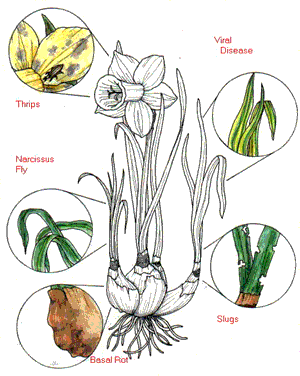 |
| Daffodil Problems | |
|---|---|
| Symptom | Probable Cause |
| Buds Dry Before Opening; Brown Spotted Leaves | Weather |
| Bulbs Do Not Flower | Shallow Planting |
| Leaves Develop Long Yellow Streaks | Stripe Virus |
| Plants Stunted; Die Prematurely | Basal Rot |
| Ragged Holes in Leaves | Slugs Or Snails |
| Bulbs Softened; Plants Yellowed | Narcissus Bulb Fly |
| Leaves and Flowers Turn Silver & Brown & Die | Thrips |
Buds Dry Before Opening; Brown Spotted Leaves, Stems Due To Weather
Daffodil buds, especially double-flowered types, may dry out and turn brown before opening due to extreme environmental conditions. “Blast” means that the buds have been nipped by either a hard freeze or hot spell at a critical time. Lack of sufficient moisture during the growing season contributes to the problem.
Daffodil leaves and stems touched by early spring frosts may show small brown spots that later merge into blotches. Sometimes leaves split and look ragged. Prevent this by spreading a 2 or 3 inch layer of organic mulch over the bulbs after the ground freezes.
Protect emerging daffodils from extreme cold with garden fleece. Use shade cloth to reduce heat. Fall fertilizing with a slow-acting product rich in potassium helps this problem. If this is a chronic problem, look for daffodils which are resistant to blast, such as: ‘Tahiti’, ‘Unique’, ‘Sir Winston Churchill’ and others.
Bulbs Do Not Flower Because Of Shallow Planting
If daffodil bulbs are not planted deeply enough, they produce short, unattractive leaves and stems. Underground they split up prematurely and produce small, non-flowering bulbs. Plant bulbs 6 to 9 inches deep. Mulch their beds over the winter with 1 to 2 inches of organic material to protect bulbs from heaving to the surface when the soil is disturbed by temperature fluctuations over the winter.
Leaves Develop Long Yellow Streaks Due To The Viral Disease Stripe
There is no cure for this virus which causes ugly yellow stripes on daffodil foliage. Dig up affected plants and discard them in the trash as soon as you are sure this disease is present. Wash your hands before handling other bulbs or plants. Control aphids on other plants in the area because they carry the virus.
For more information see the file on :Dealing with Aphids.
Plants Stunted, Die Prematurely Because Of Basal Rot
This fungus disease attacks daffodil bulbs when soil temperatures are around 65&temp; to 75&temp;F. It stunts growth and retards root development. Eventually the bottom of the bulb develops a soft brown rot.
Discard diseased bulbs and avoid injuring healthy ones when planting. Be sure they have well-drained soil and do not fertilize them in the spring if this fungus is a threat. When dividing daffodils, dig up bulbs in cool, dry weather, and dry them rapidly. Plant daffodils in a different location if some were infected the previous season because disease spores persist in the soil for years.
Bulbs Softened And Plants Yellowed By Narcissus Bulb Fly
This large hairy fly resembles a bumblebee. Its larvae live in daffodil bulbs, giving them a spongy texture and causing them to rot. Prevent the larvae by them by soaking bulbs that may be infected for 1-1/2 hours in hot water at 110&temp;F before planting. Discard any bulbs that feel soft immediately into the trash.
Leaves and Flowers Turn Silver, Brown, and Die Because Of Thrip Infestation
Thrips are tiny, feathery-winged insects that burrow deeply into flowers and foliage, sucking juices from their tissues and leaving scars. Leaves and flowers turn silvery and then die. Thrips also sometimes carry virus diseases to plants. They especially like white flowers. For information see the file Controlling Thrips.

